JustCo Co-founder and COO Lu Liu talks about the coworking brand’s rapid expansion in the Asia Pacific region and the new challenges and opportunities that come with it.

October 25th, 2019
The year 2019 has been a very busy year for coworking brand JustCo. In the last three years, JustCo’s square footage has tripled. It won the heart of property developer giants GIC and Frasers last year, who came in as investors. This year, it expanded to Taiwan and Australia.
Today, it operates 38 coworking centres in eight cities across the Asia Pacific, with and has a growing list of large enterprise clients with bespoke demands that has made it necessary to form its own in-house design team. JustCo Co-Founder Lu Liu shares more:

Lu Liu
JustCo has expanded to Taiwan and Australia. Can you share more about the design concepts of JustCo location in these countries? What makes them unique and how do they fit in the working culture in the city?
We tried to have a consistent design DNA in every JustCo locations make our members feel comfortable and at home when they recognise the JustCo identity in whichever location they go. At the same time, we try to inject some local elements.
In JustCo Centre in Hung Tai Financial tower in Taiwan, for example, we commissioned local artists for the murals which revolve around two themes: local food and scenery.

On a deeper level, Taiwan as a country, in general, has made more efforts to be environmentally friendly, so we have introduced more recycled materials in the interior in partnership with MINIWIZ. Our design team got in touch with them – they’ve been around for 16 years and headquartered in Taipei – and we saw that their products are very versatile and applicable.
We use MINIWIZ’s recycled Polli-ber Bricks for the backdrop of the reception counter and many other interior elements throughout the centre like the coffee tables and the upholstery for the furniture.
Australians like to conduct their business in a casual setting. So we designed spacious common areas, especially the cafe so they can comfortably meet over coffee in the centre.
We’re very proud that we are the only Asian coworking operator with a multi-city presence in Asia. We’re in Singapore, Seoul, Taipei, Jakarta, Bangkok, Sydney, Melbourne, Shanghai – eight cities, so we have the network offering in this region. And with GIC and Frasers’ backing, we’ve started expanding more aggressively.
Coworking needs to have large communities and diverse partners to offer to their members so expanding the scale will be our priority in the next few years in the markets that we’ve entered.
But getting people through the door is only the first step. The next one is how to retain them with a great customer journey. We make sure we listen to our customers via one on one meeting as well as surveys to find out how we can improve and create the most productive experience for them, from adjusting the design elements to the choices of tea in the pantry.

JustCo Centre Minsheng Jianguo, Taipei
Siren Design has been your design partner since 2015 but you also have an in-house design team. Tell me more about that.
Our in-house design team was formed this year and they are mainly here to cater to our enterprise clients. We’ve had Fortune 500 companies joining us since last year. Big companies that have been with us and needed space for 30-50 people in their first years and would like to take our space as is.
Then they grew into 100-200 people, and sometimes they have the entire floor, and they would like a bespoke design, that’s where the in-house design team come in. They work with the client’s design team and design guidelines and take care of the submission within the allocated turnaround time, which sometimes is very tight.
We started with five people in the team, and today we have ten because of the demand from clients such as GE and Wilson Associates.
We start with the layout; it’s all about efficiency. We have a system to figure out the optimum number of hot desks versus private studios, how much to dedicate to common area versus the private area. We create our brief with this then we involve our design partner Siren Design and in some locations also a local designer.

JustCo Centre Dian Shih, Taipei
First is getting the prime real estate in the markets we’re in. Both GIC and Frasers are heavyweight property developers who have helped us to enter the China, Korea and Thailand markets.
The second biggest challenge is localisation. I’ve mentioned the different design, but we also adjust the customer service. We always hire a local GM who speaks the local language from relevant sectors and a sales and marketing team of local talents as well.
The third one is standardisation. As much as we need localisation, we also need to make sure that we have consistency in terms of our service delivery. Like Starbucks might tweak its menu according to countries, but the quality of the coffee is consistent.
That’s why we have a department called the Centre of Excellence, which consists of trainers. They have been with us for a long time and live and breathe JustCo DNA. They do the training for local teams for a few months in each location.
A few factors. Firstly, the overall economics – whether there is enough demand. Secondly, future potential. Like Jakarta, the city does not necessarily have all the money today but we a lot of potential because it has a robust, young tech sector.

JustCo Marina Square, Singapore
One is definitely the enterprise clients. We’ve always seen the demand, but these days they’re coming in big. They want huge spaces for proper headquarters, not just a rep office, which needed to be designed according to their corporate needs and identity.
We’ve also seen a diversification of our members, with more companies from, let’s call it traditional, sectors joining us, like accounting firms, which generally are not associated with the types of creatives companies that choose a coworking space as their office.
We have also partnered with schools like the Columbia business school and SMU so their students and alumni can come in and use the hot desks. These partnerships started with hosting the school for events. We’re very open to partnering with other schools and other companies that will add vibrancy to our community.
A searchable and comprehensive guide for specifying leading products and their suppliers
Keep up to date with the latest and greatest from our industry BFF's!

Channelling the enchanting ambience of the Caffè Greco in Rome, Budapest’s historic Gerbeaud, and Grossi Florentino in Melbourne, Ross Didier’s new collection evokes the designer’s affinity for café experience, while delivering refined seating for contemporary hospitality interiors.

Savage Design’s approach to understanding the relationship between design concepts and user experience, particularly with metalwork, transcends traditional boundaries, blending timeless craftsmanship with digital innovation to create enduring elegance in objects, furnishings, and door furniture.

In the pursuit of an uplifting synergy between the inner world and the surrounding environment, internationally acclaimed Interior Architect and Designer Lorena Gaxiola transform the vibration of the auspicious number ‘8’ into mesmerising artistry alongside the Feltex design team, brought to you by GH Commercial.

Sub-Zero and Wolf’s prestigious Kitchen Design Contest (KDC) has celebrated the very best in kitchen innovation and aesthetics for three decades now. Recognising premier kitchen design professionals from around the globe, the KDC facilitates innovation, style and functionality that pushes boundaries.

Paying homage to that wonderful tool of life, the book, SJK Architects’ design for the new headquarters of Penguin Random House is both a temple to the library and a captivating place to work.

Simon Liley, Principal Sustainability Consultant at Cundall, writes about how cyberpunk dystopias haven’t (quite) come to pass yet – and how designers can avoid them.
The internet never sleeps! Here's the stuff you might have missed

Elevate your experience with Saturday Indesign’s VIP Studio Bus Tours.

Leading the charge for sustainable design, X+O and Nudie Jeans are both making a statement in Brisbane and doing it with creativity and innovation.

In the pursuit of an uplifting synergy between the inner world and the surrounding environment, internationally acclaimed Interior Architect and Designer Lorena Gaxiola transform the vibration of the auspicious number ‘8’ into mesmerising artistry alongside the Feltex design team, brought to you by GH Commercial.